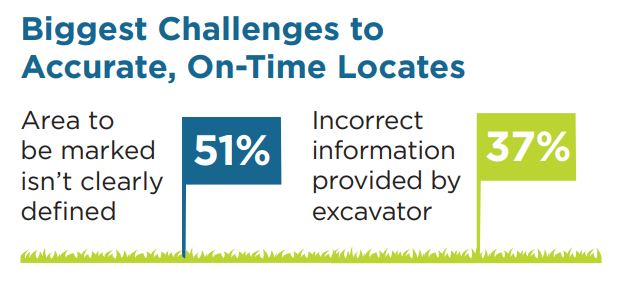Locators’ Wish List: Updated maps, Mandatory White-Lining and Better Communication
 When asked what would be most effective in improving likelihood of accurate and on-time locates, there was very broad consensus on locators’ top three asks: updated facility maps, mandatory white-lining and increased communication between the excavator and the locate technician. While these responses are perhaps unsurprising, the near-universal agreement from locators on the efficacy of these measures is telling -- as is their similarity to locators’ biggest challenges. Surveyed locators said their two biggest challenges to completing locates accurately and on-time included that the area to be marked is not clearly defined, and receiving inaccurate or insufficient information from the excavator regarding the jobsite.
When asked what would be most effective in improving likelihood of accurate and on-time locates, there was very broad consensus on locators’ top three asks: updated facility maps, mandatory white-lining and increased communication between the excavator and the locate technician. While these responses are perhaps unsurprising, the near-universal agreement from locators on the efficacy of these measures is telling -- as is their similarity to locators’ biggest challenges. Surveyed locators said their two biggest challenges to completing locates accurately and on-time included that the area to be marked is not clearly defined, and receiving inaccurate or insufficient information from the excavator regarding the jobsite.
White-lining and accurate maps have both been identified as essential to the damage prevention process and are included in CGA’s Best Practices. However, not all stakeholders have embraced these practices, suggesting that increased adoption across all damage prevention industries would help ensure that locators have the best information to complete their critical jobs. As for communication, when asked about their own adherence to safe digging best practices, locators acknowledged that they themselves could also improve the flow of information: 46% said they did not always communicate with on-site excavators or stakeholders, and 31% said they did not always notify one call centers of the status of tickets as required.
Enhance Opportunities for Experience and Training
 Locating and marking underground infrastructure is a job that carries a significant workload, requires skill and ingenuity, and benefits greatly from training and experience. CGA’s research found that while eight in 10 locate technicians felt that their daily workload was manageable, those who felt it was not manageable were more likely to have less job experience and fewer training opportunities.
Locating and marking underground infrastructure is a job that carries a significant workload, requires skill and ingenuity, and benefits greatly from training and experience. CGA’s research found that while eight in 10 locate technicians felt that their daily workload was manageable, those who felt it was not manageable were more likely to have less job experience and fewer training opportunities.
While locate technicians appear to almost universally have access to training -- primarily through their employers -- it seems to occur mostly at the beginning of their careers. Only 20% reported receiving continued education training on a quarterly basis, while 42% said they receive it yearly, 10% received it less than once a year, and 19% said they have never received additional training. These figures indicate that there are significant opportunities to expand locate technician training across technology platforms and stakeholders to improve the accuracy and speed of locates.
Locators are Committed, Accountable Damage Prevention Stakeholders
Most encouragingly, CGA’s survey of U.S. locators found that these technicians are incredibly dedicated to safety and accountability. Virtually all respondents (98%) agreed that locators are very important to the safe digging process and reported being aware of each of the steps in the safe digging process (97-100%). When using a 10-point scale to measure their job performance, locators said completing locates accurately (9.6/10), safely (9.3/10) and on time (9.1/10) are most important to them. A full 97% of locators said that improving the safety of a jobsite through timely and accurate locates was important to them, and 94% said they felt it was important to their companies. The most-cited motivator for accurate and on-time locates for technicians was the safety of those who live and work around the jobsite.

It is important to note that locators are aware of opportunities for improvement: 61% of locators said they believe that late locates occur frequently, and 50% believe inaccurate locates occur frequently. Locate technicians also acknowledge accountability. When asked what they believe is the most common underlying cause of damages when locating issues are indicated, those surveyed pointed to error by the locate technician as the most likely cause.